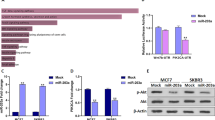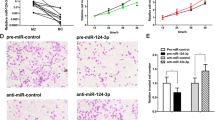Abstract
Abnormal expression of miRNAs is closely related to the occurrence and development of tumors, and thus has become the most concerned biomolecule in the field of tumors. But so far, miRNAs that are truly recognized and studied for their function are only a small part, and their mechanism in tumors needs to be further studied. In this study, we identify that miR-3148 is downregulated in the development of cervical cancer. In cervical cancer cells, upregulated miR-3148 inhibits cell proliferation and promotes apoptosis, suggesting that miR-3148 acts as a tumor suppressor gene. Furthermore, we explored the mechanism of miR-3148 in cervical cancer cells from both transcriptional and post-transcriptional levels. Our research reveals that on the one hand, bromodomain containing 7 (BRD7) acts as a transcription factor to up-regulate the expression of miR-3148 at the transcriptional level; on the other hand, miR-3148 targets the 3′UTR of Wnt3a mRNA to inhibit Wnt3a expression at the post-transcriptional level, thereby suppressing Wnt3a/β-catenin signaling pathway and exerting its tumor suppressor role in cervical cancer. In conclusion, our study elucidates the mechanism of BRD7/miR-3148/Wnt3a/β-catenin pathway in cervical cancer and provides a new research direction for targeted therapy of cervical cancer.





Similar content being viewed by others
Data Availability
The data used to support the findings of this study are available from the corresponding author upon request.
References
Ferlay J, Soerjomataram I, Dikshit R, Eser S, Mathers C, Rebelo M, et al. Cancer incidence and mortality worldwide: sources, methods and major patterns in GLOBOCAN 2012. Int J Cancer. 2015;136(5):E359–86.
Goodman A. HPV testing as a screen for cervical cancer. BMJ. 2015;350:h2372.
Lee H, Han S, Kwon CS, Lee D. Biogenesis and regulation of the let-7 miRNAs and their functional implications. Protein Cell. 2016;7(2):100–13.
Deng R, Zhang K, Li J. Isothermal amplification for microRNA detection: from the test tube to the cell. Acc Chem Res. 2017;50(4):1059–68.
Kontomanolis EN, Koukouli A, Liberis G, Stanulov H, Achouhan A, Pagkalos A. MiRNAs: regulators of human disease. Eur J Gynaecol Oncol. 2016;37(6):759–65.
Tutar Y. miRNA and cancer; computational and experimental approaches. Curr Pharm Biotechnol. 2014;15(5):429.
Kappel A, Keller A. miRNA assays in the clinical laboratory: workflow, detection technologies and automation aspects. Clin Chem Lab Med. 2017;55(5):636–47.
Mishra S, Yadav T, Rani V. Exploring miRNA based approaches in cancer diagnostics and therapeutics. Crit Rev Oncol Hematol. 2016;98:12–23.
Robb T, Reid G, Blenkiron C. Exploiting microRNAs as cancer therapeutics. Target Oncol. 2017;12(2):163–78.
Akamine T, Morodomi Y, Harada Y, Teraishi K, Tagawa T, Okamoto T, et al. miR-3148 is a novel onco-microRNA that potentiates tumor growth in vivo. Anticancer Res. 2018;38(10):5693–701.
Oger F, Gheeraert C, Mogilenko D, Benomar Y, Molendi-Coste O, Bouchaert E, et al. Cell-specific dysregulation of microRNA expression in obese white adipose tissue. J Clin Endocrinol Metab. 2014;99(8):2821–33.
Li K, Ma YB, Zhang Z, Tian YH, Xu XL, He YQ, et al. Upregulated IQUB promotes cell proliferation and migration via activating Akt/GSK3beta/beta-catenin signaling pathway in breast cancer. Cancer Med. 2018;7(8):3875–88.
Spassky N, Meunier A. The development and functions of multiciliated epithelia. Nat Rev Mol Cell Biol. 2017;18(7):423–36.
Faurobert E, Bouin AP, Albiges-Rizo C. Microenvironment, tumor cell plasticity, and cancer. Curr Opin Oncol. 2015;27(1):64–70.
Nusse R, Clevers H. Wnt/beta-catenin signaling, disease, and emerging therapeutic modalities. Cell. 2017;169(6):985–99.
Majidinia M, Aghazadeh J, Jahanban-Esfahlani R, Yousefi B. The roles of Wnt/beta-catenin pathway in tissue development and regenerative medicine. J Cell Physiol. 2018;233(8):5598–612.
Clevers H. Wnt/beta-catenin signaling in development and disease. Cell. 2006;127(3):469–80.
Liu H, Zhang L, Niu Z, et al. Promoter methylation inhibits BRD7 expression in human nasopharyngeal carcinoma cells. BMC Cancer. 2008;8:253.
Yu X, Li Z, Shen J. BRD7: a novel tumor suppressor gene in different cancers. Am J Transl Res. 2016;8(2):742–8.
Zhou M, Liu H, Xu X, Zhou H, Li X, Peng C, et al. Identification of nuclear localization signal that governs nuclear import of BRD7 and its essential roles in inhibiting cell cycle progression. J Cell Biochem. 2006;98(4):920–30.
Peng C, Zhou J, Liu HY, Zhou M, Wang LL, Zhang QH, et al. The transcriptional regulation role of BRD7 by binding to acetylated histone through bromodomain. J Cell Biochem. 2006;97(4):882–92.
Sun H, Liu J, Zhang J, Shen W, Huang H, Xu C, et al. Solution structure of BRD7 bromodomain and its interaction with acetylated peptides from histone H3 and H4. Biochem Biophys Res Commun. 2007;358(2):435–41.
Staal A, Enserink JM, Stein JL, Stein GS, van Wijnen AJ. Molecular characterization of celtix-1, a bromodomain protein interacting with the transcription factor interferon regulatory factor 2. J Cell Physiol. 2000;185(2):269–79.
Drost J, Mantovani F, Tocco F, Elkon R, Comel A, Holstege H, et al. BRD7 is a candidate tumour suppressor gene required for p53 function. Nat Cell Biol. 2010;12(4):380–9.
Harte MT, O'Brien GJ, Ryan NM, Gorski JJ, Savage KI, Crawford NT, et al. BRD7, a subunit of SWI/SNF complexes, binds directly to BRCA1 and regulates BRCA1-dependent transcription. Cancer Res. 2010;70(6):2538–47.
Wu M, Li X, Li X, Li G. Signaling transduction network mediated by tumor suppressor/susceptibility genes in NPC. Curr Genomics. 2009;10(4):216–22.
Peng C, Liu HY, Zhou M, Zhang LM, Li XL, Shen SR, et al. BRD7 suppresses the growth of nasopharyngeal carcinoma cells (HNE1) through negatively regulating beta-catenin and ERK pathways. Mol Cell Biochem. 2007;303(1–2):141–9.
Leppek K, Das R, Barna M. Functional 5′ UTR mRNA structures in eukaryotic translation regulation and how to find them. Nat Rev Mol Cell Biol. 2018;19(3):158–74.
Wilkie GS, Dickson KS, Gray NK. Regulation of mRNA translation by 5′- and 3′-UTR-binding factors. Trends Biochem Sci. 2003;28(4):182–8.
Jia J, Yao P, Arif A, Fox PL. Regulation and dysregulation of 3′UTR-mediated translational control. Curr Opin Genet Dev. 2013;23(1):29–34.
Li K, Xu X, He Y, et al. P21-activated kinase 7 (PAK7) interacts with and activates Wnt/beta-catenin signaling pathway in breast cancer. J Cancer. 2018;9(10):1821–35.
Funding
The project was supported by Natural Science Basic research Plan in Shaanxi Province of China (2016JQ8058).
Author information
Authors and Affiliations
Corresponding author
Ethics declarations
Our study was approved by the Ethics Board of Affiliated Hospital of Qinghai University and was performed in accordance with the principles of the Declaration of Helsinki.
Conflict of Interest
The authors declare that they have no conflict of interest.
Funding
The project was supported by Natural Science Basic research Plan in Shaanxi Province of China (2016JQ8058).
Additional information
Publisher’s Note
Springer Nature remains neutral with regard to jurisdictional claims in published maps and institutional affiliations.
Rights and permissions
About this article
Cite this article
Wang, H., Xie, Y. BRD7-Mediated miR-3148 Inhibits Progression of Cervical Cancer by Targeting Wnt3a/β-Catenin Pathway. Reprod. Sci. 27, 877–887 (2020). https://doi.org/10.1007/s43032-019-00091-8
Received:
Accepted:
Published:
Issue Date:
DOI: https://doi.org/10.1007/s43032-019-00091-8




